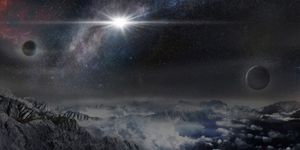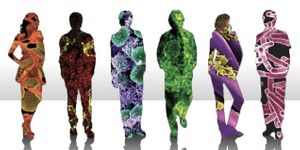When the American Astronomical Society met recently in Florida, there was a great deal of attention surrounding a particular presentation. Researchers from the United States and Australia had discovered a gas cloud that they believed contained evidence of the first stars in the universe. A finding like this is significant because the composition of the cloud indicated it had been formed just after the beginning of time. Here’s some more information on who the researchers are and how they came across this piece of the universe from so long ago.

Dr. Neil Crighton, a professor at the Center for Astrophysics and Supercomputing at Swinburne University of Technology near Melbourne Australia worked with Swinburne colleague Professor Michael Murphy and a visiting professor from the United States, Dr. John O’Meara from Saint Michael’s College in Vermont. Together they combed through the archives of data from two ground-based telescopes, the W.M. Keck telescope at Mauna Kea Hawaii and the Very Large Telescope in Chile.
Data from the observations these telescopes record is available for scientists and researchers. The team at Swinburne set out to look through the volumes of information gathered with a fresh set of eyes to see if there was something that hadn’t been addressed before. As it turned out there was.
LabRoots spoke with Dr. John O’Meara from Saint Michael’s College about the discovery and his presentation of the data at the American Astronomical Society conference earlier this month. He is passionate about physics and finding information on how the universe was formed. He holds a BS from the University of Washington and received his PhD from the University of California, San Diego. He completed a post-doctoral fellowship at the Massachusetts Institute of Technology and now teaches physics and astronomy at Saint Michael’s College, a small liberal arts college in Colchester VT. While most cosmologists with a resume like O’Meara’s might be found at larger universities, he is happy at this smaller school because it allows him to interact more directly with his students by making the field of astronomy and astrophysics relevant in their world.
Dr. O’Meara is no stranger to finding significant astronomical features in the universe. In 2011, with colleagues from the University of California, Santa Cruz, he found two giant clouds of intergalactic gas that likely resulted from the Big Bang. Dr. O’Meara explained that just after the Big Bang---which was not actually an explosion but rather a series of nuclear reactions---the three lightest elements hydrogen, helium, and a tiny bit of lithium were created. When stars were formed, they converted some of these lighter elements to heavy elements like carbon and oxygen.
The composition of the two clouds found in 2011 was pristine, containing no heavy elements. The discovery of these two clouds was the first time astronomers had been able to locate clouds that were devoid of carbon or oxygen.
Physics World Magazine called their finding one of the Top Ten Breakthroughs for 2011.
In his work at Swinburne, Dr. O’Meara used a technique that he says has been around for “decades.” Using quasar absorption line physics, Dr. O’Meara and the team in Australia found another gas cloud, this time with fractional amounts of carbon, oxygen and iron. A cloud such as this is likely to have formed as a result of a supernova of the first stars ejecting their mass into the cosmos. The tiny amounts of heavy elements found in this cloud indicate that it may have come from the very earliest stars created at beginning of the universe. These stars are called Population III stars, and they were formed differently than stars later on since they are a result of clouds that contained only the purest primordial gas from the Big Bang.
Quasar absorption line physics allows researchers to calculate the composition of astronomical objects by using the light from distant galaxies that contain super bright quasars at the center. The light from these quasars passes through objects allowing them to be seen. O’Meara compared it to shining a laser pointer through a fish tank. The light passes through the water, but if food coloring is added, the light illuminates that just as a quasar illuminates gas clouds, creating a spectra of light and information that can be observed. Dr. O’Meara called it a “Trick of science in silhouette” where information about a cloud that was likely formed 2 billion years after the Big Bang can be observed and defined today.
Dr. O’Meara and his colleagues came across the cloud by analyzing the data from two of the world’s most efficient ground-based telescopes. The W.M. Keck Telescope in Hawaii and the Very Large Telescope in Chile provided O’Meara and his team with the information used in their discovery. Data from the universe including our solar system, the Milky Way and other more distant galaxies is collected constantly by these two telescopes and archived. O’Meara was a visiting fellow at Swinburne and together with Dr. Crighton and Professor Murphy searched through the archives looking for anything that might not have been analyzed in depth before. By taking a closer look at some of this data, the team came up with their theory that this particular cloud was likely to have been formed by the explosion of some of the universe’s very first stars.
The contents of the cloud are what indicated that it has been around since almost the beginning of time. It contained only about one thousandth of the fraction of heavy elements that our Sun contains. Clouds that were formed in the early days of the universe are thought to have only minute traces of the heavy elements created when stars form.
“This is the first cloud to show the tiny heavy element fraction expected for a cloud enriched by the first stars,” said O’Meara. He cautioned however that their interpretation of the data is not the only possible explanation and that more research should be done to find other clouds like this. He told LabRoots, “You never want to trust the statistic of one.”
Dr. O’Meara explained that going forward, the kind of research he and his team conducted will be valuable when it comes to “Proposing research and applying for time on the telescopes.” Time on the various telescopes like the Keck in Hawaii, the VLT in Chile and even NASA’s Hubble telescope must be applied for, with a detailed proposal of the research that will be done and why the telescope is necessary. From the time a proposal is submitted to when it is (hopefully) approved can be six months or more. After that, it’s possible that the time granted could be 9 -10 months out. When a researcher is assigned a time slot, it’s use it or lose it. O’Meara said it was like being on call, “If you get the approval and they tell you your allotted time is on Christmas Eve, you go.”
Significant results like the data and interpretation that came out of the work O’Meara did with his team at Swinburne can only help other scientists looking further to find more of these clouds. The scientific community now knows it is possible and he believes that the cloud his team came across is not the only one. “I believe there have to be more and they will be found.”
When asked about the reception the presentation received at the AAS conference this month, O’Meara was encouraged by the attention and hopeful that more work will be done to find out as much as humanly possible about how the universe was formed. Looking back on the project, his time in Australia with colleagues Crighton and Murphy and the publication and presentation of their work, O’Meara said, “It’s been a good year, no question.”
The research conducted by Dr. O’Meara and his colleagues at Swinburne was published in The Monthly Notices of the Royal Astronomical Society and can be seen
here









